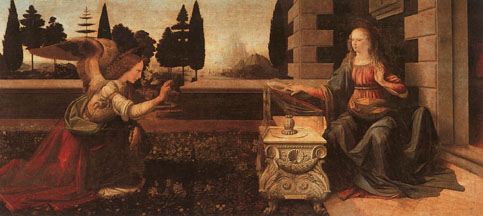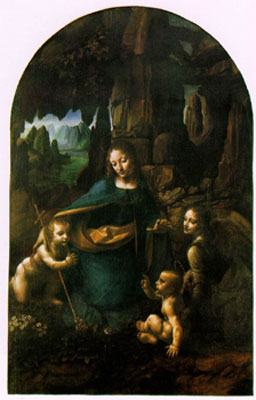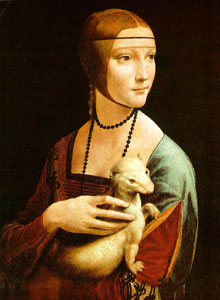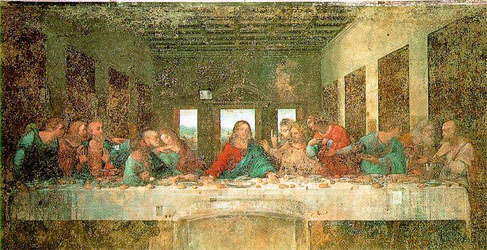LEONARDO'S
PAINTINGS
As a result of his varied
interests, Leonardo only completed a handful of paintings in his lifetime.The
authenticity of those which scholars are certain of relate primarily to his
working sketches.

"The Annunciation"
(1473), for example, is authenticated by a drawing of Mary's sleeve and upraised
hand. It is only in such an early example which Leonardo would paint halos
for both figures, and wings on the angel. His later works ridded such supernatural
devices.

|
The
Virgin of the Rocks is a rare finished work which has been attributed
to Leonardo's hand. Mary has been placed in a grotto, instead of an architectural
setting. The identification of the individuals are known through their gestures.
Mary raises her hand over the infant Jesus' head in an expression of protection.
Jesus raises his hand symbolic of his sovereignty and grace. St. John assumes
a position of blessing. The most curious gesture is that of the angel (this
time without wings), who points at St. John. It is suggested that only a
Florentine would understand this, as St. John was the patron saint of Florence. |
There
are two versions of the Virgin of the Rocks which have been long disputed
as to which is by Leonardo's hand and which is a copy (one in the Louvre in
Paris, the other in the London Gallery of Art). One piece of evidence that
points to the authenticity of the Louvre copy is this preparatory drawing
of a woman (found in Leonardo's notebooks), which closely approximates that
of the angel in the painting.

|
Lady
With Ermine is a portrait of Cecilia Gallerani. This is one of my favorite
Leonardo paintings. It is interesting to note that the lady was the mistress
of the Duke of Milan, and that the ermine was at the time considered an
emblem of chastity. Another note is that the word for the animal in Greek
is "galee", which may be a pun on Ms. Gallerani's name. |
The
Last Supper
Leonardo painted the image of Jesus
among his disciples in the refectory of the Monastery of Sta. Maria delle
Grazie between 1495-97. This was by commission of the Duke of Milan, who also
had him paint a Crucifixion on the opposite wall (with images of himself and
his family as witnesses). Instead of using the traditional fresco technique,
Leonardo experimented with a mixture of tempera and oil on the stone wall.
Fluctuations in humidy caused the paint to crumble off the wall within 15
years of its completion. Giorgio Vasari (a historian who chronicled "Lives
of the Artists", written at the end of the Renaissance) wrote that it
was "a mass of blots" within only 60 years of its creation.

To make matters worse, it suffered
further damage by those intending to restore and preserve it. There were a
total of 7 restorations to the work, the first beginning in 1726. One of the
restorers used a strong solvent (attempting to clean off the grime) which
dissolved some of Leonardo's original colors. Another used a strong glue (attempting
to seal it), which attracted more dirt. Others attempted to fill in the missing
paint, though their abilities were far below Leonardo's (one such painter
gave one of the apostles six fingers!). Further damage was created by the
friars themselves, who installed a curtain over the piece to protect it. Instead,
it trapped moisture between the curtain and the mural, and more paint flaked
off each time the curtain was opened to reveal it. Later, Napoleon's soldiers
used the space as a stable, threw rocks at it, and climbed ladders to scratch
out the apostle's eyes. During WWII, a bomb barely missed the mural by a few
feet. It is a wonder that the mural remains at all.
The most recent renovation was
undertaken by a Milanese woman, Dr. Pinan Branbilla Barcilon. Beginning in
1977, she spent more than 20 years restoring the masterpiece. Aided by modern
microscopes, measuring devices, and chemicals, she has removed all of the
previous restorers' work and left only that which was created by the hand
of Leonardo (which accounts for only 30-40% of the surface of the mural).
In the intervening spaces, she has painted watercolors in neutral colors (which
can be easily differentiated and removed).
Mona
Lisa
| Painted in Florence,
the sitter's name was Lisa di Noldo Gherardini. At the time of the portrait,
she was recently married to Francesco del Giocondo, a merchant who was
twice widowed. It is mentioned that she is wearing the colors of mourning,
though it is unsure who's death she may be grieving (my personal thought
is that it is her marriage to what must have been a much older man!)
It has also been mentioned that Leonardo had to hire musicians to keep
her amused and to prevent her from looking too sad. Perhaps this is
the appeal of her so-called "mysterious smile"... that her
smile is mixed with sadness. She also seems to be both confident and
shy. Leonardo is known for his attraction to such contradictions. Perhaps
her fame is overblown, but it is known that this was one of Leonardo's
favorite paintings... and its commissioner had a difficult time getting
Leonardo to part with it. I have read one account that the King of France
requested its possession when Leonardo was under his employment. Another
account says that he willed the painting to a pupil (Salai) upon his
death. In either case, it was found in the Versailles Palace during
the French revolution, and was subsequently placed in the Louvre, in
Paris. |
|
| Although I don't personally support this thesis, I think
the following is of some interest: Dr. Lillian Schwartz of Bell Labs suggests
that Leonardo painted himself, supporting her theory by analyzing the
facial features of Leonardo's face and that of the famous painting. She
digitized both the self-portrait of the artist and the Mona Lisa, then
flipped the self portrait and merged the two images together using a computer.
She noticed the features of the face aligned perfectly! |

|
to Michelangelo
|

